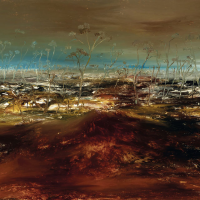63. SIDNEY NOLAN

Of any figure in Australian art, Sidney Nolan most closely resembles the archetype of the artist-adventurer: an intrepid personality who would journey to far-flung areas of the world in search of new and varied imagery. Nolans compulsive globetrotting was at its height in the 1960s, when he travelled to six continents within the space of five years to West Africa in 1962, Greece in 1963, Australia and Antarctica in 1964, China and Southern Asia in 1965, and New York in 1966 with time spent in London in between.1 As he discovered the world, the world discovered him: Nolans international reputation had never been greater. And yet, the overarching character of his art would remain unequivocally Australian. Time and again, Nolan would return to the mythology of his homeland in the shape of Ned Kelly or Burke and Wills, overcoming the bounds of time and space to evoke the heat, distance and colour of Australia.
Nolans diaristic tendency to date his paintings to an exact day is a gift for art historians, since it allows us to pinpoint the context of their creation and examine the progression of a series through time. The present work, Landscape 1966, was painted on 11 September of that year, placing it in close proximity to two other works created that month: Salt Lakes, Wimmera, painted on 6 September 1966 (private collection, offered with Sothebys Australia in April 2015);2 and Landscape, painted on 28 September 1966 (private collection, offered with Deutscher + Hackett in November 2021).3 Of these, Salt Lakes, Wimmera is the closest to the present work in its use of a broad, panoramic format. In each case, the horizon is elevated to present an immersive view of the landscape. Foreground and background are condensed to evoke the monotony of distance: repetition after repetition of what we can already see.4 In the centre of the present work, we see a swirling maelstrom of dust and dirt what Patrick Aelfred Hutchings described as an inferno of grit.5 The harsh effects of heat and salt are felt in the straggling vegetation of this landscape, with trees that are blanched and almost stripped bare.
The apparent spontaneity of Nolans mark making in Landscape 1966 belies the fact that this painting was born of memory, rather than direct observation. As with Nolans imagery of more exotic places, Landscape has been created in retrospect, after much gestation in the mind.6 The resulting image is an amalgam of quite disparate Australian landscapes; a merging of the desolate scenery that confronted Burke and Wills on their fateful journey through central Australia, and the drab, tree-speckled undulations7 of the Wimmera in western Victoria, where Nolan had spent his military service during World War II. For Nolan, the finite details of a landscape were less important than its prevailing spirit. In Landscape, Nolan has succeeded in capturing the texture, the light and the haunting space8 of Australia at large.
Footnotes:
1. Rosenthal, T., Sidney Nolan, Thames & Hudson, London, 2002, biographical details
2. Salt Lakes, Wimmera 1966, oil on board, 122.0 x 152.5 cm, private collection; sold Sothebys Australia, Sydney, 28 April 2015, lot 61
3. Landscape 1966, oil on board, 122.5 x 122.5 cm, private collection; offered Deutscher + Hackett, Melbourne, 10 November 2021, lot 90
4. Hutchings, P., Catalogue Introduction, in Sidney Nolan: Recent Paintings, Skinner Galleries, Perth, 1970, n.p.
5. Ibid.
6. Missingham, H., Sidney Nolan: Retrospective Exhibition - Paintings from 1937-1967, Art Gallery of New South Wales, Sydney, 1967, p.7
7. Harris, M., Apotheosis of the Wetlands, in Sidney Nolan: The Wimmera Paintings, David Jones Gallery, Adelaide, 1970, n.p.
8. Hutchings, P., op. cit.
Catherine Baxendale